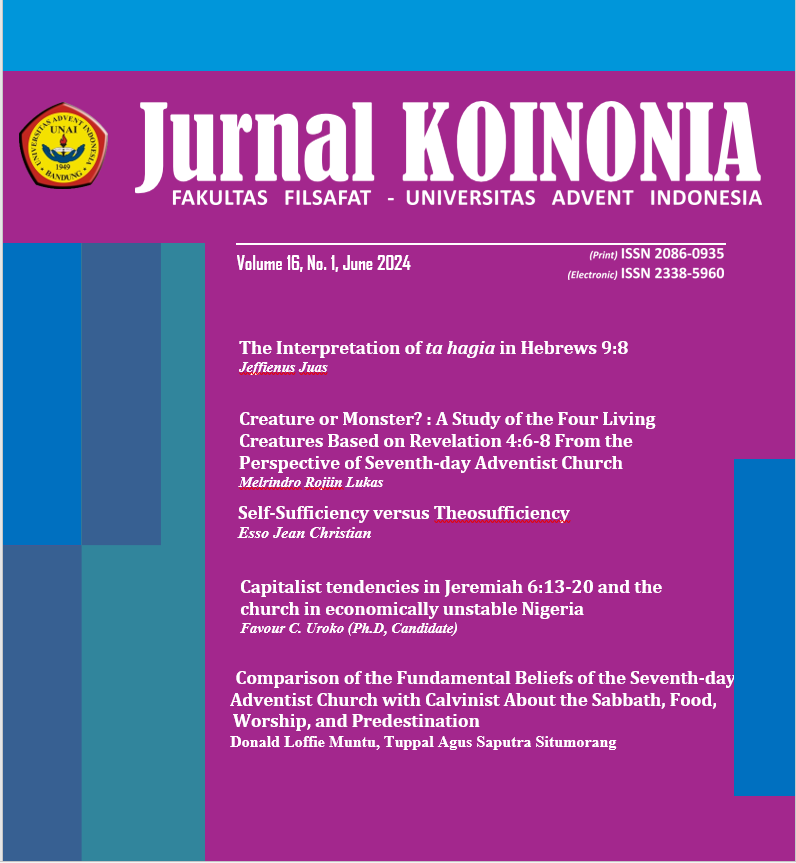Creature or Monster?: A Study of the Four Living Creatures Based on Revelation 4:6-8 from the Perspective of the Seventh-day Adventist Church
Keywords:
Four Living Creatures , Revelation, God’s ThroneAbstract
In Revelation 4:6-8, some people have the impression that God's throne is surrounded by monsters. The purpose of this research paper is to re-examine the understanding of the four living creatures according to the Seventh-day Adventist view in order to provide clarity. Revelation 4:6-8 refers to the four evangelists, Matthew, Mark, Luke, and John. In the Adventist view, the four living creatures are closely related to the identity of the twenty-four elders. However, different scholars have different views on the particular verse. In the modern view of the Adventist church, these creatures make no mention of them being metaphorical, they are genuine, physical entities. They are angels, according to Ranko Stefanovic, exalted angels of God who serve God and are guardians of His throne. The four living creatures are an elevated order of angelic beings known as cherubim or seraphim. The song of these "living ones" is the song of angels, according to William Hendriksen and Ranko Stefanovic in Isaiah 6:1-3. In the traditional view of the four living creatures, it presents some contradicting ideas. The modern view shows that there is a need to study other verse that is parallel to Revelation 4:6-8. It was revealed that the living creatures are an angelic being.
Keywords: Four Living Creatures, Revelation, God’s Throne
References
Bird, Michael F., Tremper Longman III, and Scot McKnight. The Story of God Bible Commentary: Romans. Michigan: Library of Congress Cataloging-in-Publication Data, 2016.
Carter, T.L. Paul and the Power of Sin. Cambridge: Cambridge University Press, 2002.Cf. Seneca, Moral Epistles, 180.
Dodson, Joseph R. The ‘Powers’ of Personification: Rhetorical Purpose in the Book of Wisdom and the Letter to the Romans. Berlin: Library of Congress Cataloging-in-Publication Data, 2008.
Dubar, Colin A. “Salvation by Faith Alone in Book of Romans.” In Not Under the Lawbut Under Grace, edited by Clifford R. Goldstein, 59-65. Silver Spring, MD: Pacific Press.
Dummelow. John. "Commentary on Romans 6:14." John Dummelow's Commentary on The Bible. https://www.studylight.org/commentaries/dcb/romans-6.html (accessed April 6, 2021).
Edwards, Justin. "Commentary on Romans 6:14." Family Bible New Testament.https://www.studylight.org/commentaries/fam/romans-6.html (accessed April 6,
.
Grant. “Romans 6:14.” Romans. https://versebyversecommentary.com/2012/03/09/romans-614/ (accessed
March 9, 2021).
Gill, John. "Commentary on Romans 6:14.” The New John Gill Exposition of the Entire Bible, https://www.studylight.org/commentaries/geb/romans-6.html (accessed April 6, 2021).
Gundry, Robert H. A Survey of the New Testament. Michigan: Library of Congress Cataloging- in-Publication Data, 2012.
Jewett, Robert. Romans: Hermeneia. Minneapolis: Fortress Press, 2007.
Liddell, H.G and R. Scott. A Greek-English Lexicon. 9th ed. Oxford: Clarendon Press,
Moo, Douglas J. The Epistle to the Romans. Grand Rapids: Eerdmans, 1996.
Rodriguez, Manuel Angel, “Adventist World,” The Power of Law, the Power of Grace
(2018):1-5.
White, Ellen G. Patriarch and Prophets. Washington: Review and Herald Publishing Association, 1890.
Ziesler, J.A. The Role of the Tenth Commandment in Romans. 1988.




